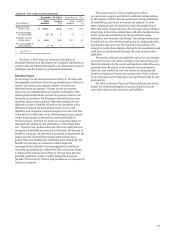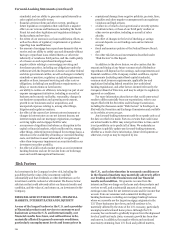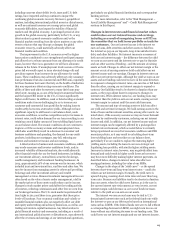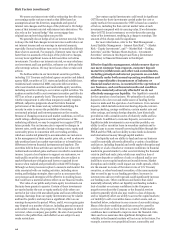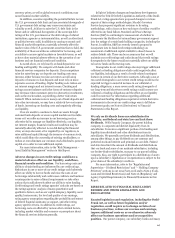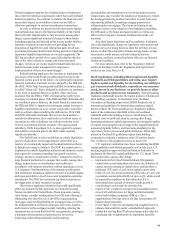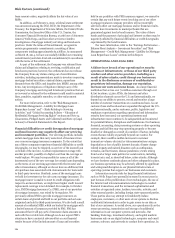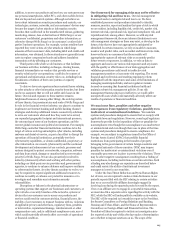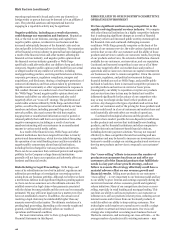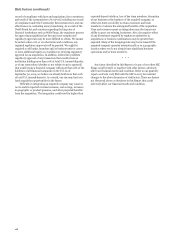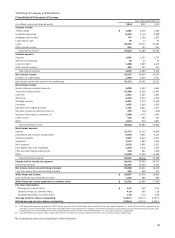Wells Fargo 2014 Annual Report Download - page 123
Download and view the complete annual report
Please find page 123 of the 2014 Wells Fargo annual report below. You can navigate through the pages in the report by either clicking on the pages listed below, or by using the keyword search tool below to find specific information within the annual report.the level of the federal funds rate. As noted above, a declining or
low interest rate environment and a flattening yield curve which
may result from the FRB’s actions could negatively affect our net
interest income and net interest margin as it may result in us
holding lower yielding loans and investment securities on our
balance sheet.
RISKS RELATED TO CREDIT AND OUR MORTGAGE
BUSINESS
As one of the largest lenders in the U.S., increased
credit risk, including as a result of a deterioration in
economic conditions, could require us to increase our
provision for credit losses and allowance for credit
losses and could have a material adverse effect on our
results of operations and financial condition. When we
loan money or commit to loan money we incur credit risk, or the
risk of losses if our borrowers do not repay their loans. As one of
the largest lenders in the U.S., the credit performance of our loan
portfolios significantly affects our financial results and
condition. As noted above, if the current economic environment
were to deteriorate, more of our customers may have difficulty in
repaying their loans or other obligations which could result in a
higher level of credit losses and provision for credit losses. We
reserve for credit losses by establishing an allowance through a
charge to earnings. The amount of this allowance is based on our
assessment of credit losses inherent in our loan portfolio
(including unfunded credit commitments). The process for
determining the amount of the allowance is critical to our
financial results and condition. It requires difficult, subjective
and complex judgments about the future, including forecasts of
economic or market conditions that might impair the ability of
our borrowers to repay their loans. We might increase the
allowance because of changing economic conditions, including
falling home prices and higher unemployment, significant loan
growth, or other factors. For example, if oil prices remain low for
a prolonged period of time, we may have to increase the
allowance, particularly to cover potential losses on loans to
customers in the energy sector. Additionally, the regulatory
environment or external factors, such as natural disasters, also
can influence recognition of credit losses in our loan portfolios
and impact our allowance for credit losses.
Reflecting the continued improved credit performance in
our loan portfolios, our provision for credit losses was
$1.6 billion and $2.2 billion less than net charge-offs in 2014 and
2013, respectively, which had a positive effect on our earnings.
Future allowance levels may increase or decrease based on a
variety of factors, including loan growth, portfolio performance
and general economic conditions. While we believe that our
allowance for credit losses was appropriate at December 31,
2014, there is no assurance that it will be sufficient to cover
future credit losses, especially if housing and employment
conditions worsen. In the event of significant deterioration in
economic conditions or if we experience significant loan growth,
we may be required to build reserves in future periods, which
would reduce our earnings.
For more information, refer to the “Risk Management –
Credit Risk Management” and “Critical Accounting Policies –
Allowance for Credit Losses” sections in this Report.
We may have more credit risk and higher credit losses
to the extent our loans are concentrated by loan type,
industry segment, borrower type, or location of the
borrower or collateral. Our credit risk and credit losses can
increase if our loans are concentrated to borrowers engaged in
the same or similar activities or to borrowers who as a group
may be uniquely or disproportionately affected by economic or
market conditions. We experienced the effect of concentration
risk in 2009 and 2010 when we incurred greater than expected
losses in our residential real estate loan portfolio due to a
housing slowdown and greater than expected deterioration in
residential real estate values in many markets, including the
Central Valley California market and several Southern California
metropolitan statistical areas. As California is our largest
banking state in terms of loans and deposits, deterioration in
real estate values and underlying economic conditions in those
markets or elsewhere in California could result in materially
higher credit losses. In addition, deterioration in macro-
economic conditions generally across the country could result in
materially higher credit losses, including for our residential real
estate loan portfolio. We may experience higher delinquencies
and higher loss rates as our consumer real estate secured lines of
credit reach their contractual end of draw period and begin to
amortize. Additionally, we may experience higher delinquencies
and higher loss rates as borrowers in our consumer Pick-a-Pay
portfolio reach their recast trigger, particularly if interest rates
increase significantly which may cause more borrowers to
experience a payment increase of more than 7.5% upon recast.
We are currently the largest CRE lender in the U.S. A
deterioration in economic conditions that negatively affects the
business performance of our CRE borrowers, including increases
in interest rates and/or declines in commercial property values,
could result in materially higher credit losses and have a
material adverse effect on our financial results and condition.
Challenging economic conditions in Europe have increased
our foreign credit risk. Although our foreign loan exposure
represented only approximately 6% of our total consolidated
outstanding loans and 3% of our total assets at
December 31, 2014, continued European economic difficulties
could indirectly have a material adverse effect on our credit
performance and results of operations and financial condition to
the extent it negatively affects the U.S. economy and/or our
borrowers who have foreign operations.
For more information, refer to the “Risk Management –
Credit Risk Management” section and Note 6 (Loans and
Allowance for Credit Losses) to Financial Statements in this
Report.
We may incur losses on loans, securities and other
acquired assets of Wachovia that are materially greater
than reflected in our fair value adjustments. We
accounted for the Wachovia merger under the purchase method
of accounting, recording the acquired assets and liabilities of
Wachovia at fair value. All PCI loans acquired in the merger were
recorded at fair value based on the present value of their
expected cash flows. We estimated cash flows using internal
credit, interest rate and prepayment risk models using
assumptions about matters that are inherently uncertain. We
may not realize the estimated cash flows or fair value of these
loans. In addition, although the difference between the pre-
merger carrying value of the credit-impaired loans and their
expected cash flows – the “nonaccretable difference” – is
available to absorb future charge-offs, we may be required to
increase our allowance for credit losses and related provision
expense because of subsequent additional credit deterioration in
these loans.
For more information, refer to the “Critical Accounting
Policies – Purchased Credit-Impaired (PCI) Loans” and “Risk
Management – Credit Risk Management” sections in this
Report.
121


